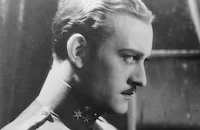The Girl from Mandalay
Cast & Crew
Howard Bretherton
Conrad Nagel
Kay Linaker
Donald Cook
Esther Ralston
Harry Stubbs
Film Details
Technical Specs

Synopsis
John Foster, a teak plantation manager in Burma, is bitterly disappointed when his fiancée Alice, whom he has not seen in four years, returns his ring and tells him that she cannot wait for him any longer. He then goes to Mandalay, a notorious red light district, where he meets Jeanie, a bar "hostess" and entertainer, whom he marries after a boozy week together. Jeanie is thrilled by her first chance at love and a respectable life, but her happiness is short-lived, for soon after her arrival at John's home, Kenneth Grainger, a fellow plantation manager and John's rowdy friend, recognizes Jeanie as a dubious acquaintance from Mandalay. John resents the reminder of Jeanie's shady past, while Jeanie becomes upset when Kenneth intimates that John must be ashamed of her because he has not introduced her to his friends. John attempts to soothe Jeanie, then leaves with Kenneth to hunt a tiger sighted in their district. John lays a trap for the tiger but daredevil Kenneth shoots and wounds it. Sometime later, Jeanie is alone when Mary Trevor, the pretty wife of John's employer, arrives to visit John. Mary assumes that Jeanie is John's fiancée from England, and becomes sarcastic once she realizes the truth. John returns home and accompanies Mary back to the trail, leaving Jeanie to stew in her jealousy. As they ride, John scrutinizes the snobbish, sly Mary, and then returns home with renewed love for unpretentious Jeanie. When he returns, however, he finds Jeanie dancing with Kenneth. John is threatening Kenneth when a servant alerts them that a native in the village has been killed by a tiger. They realize that the killer is the tiger that Kenneth carelessly wounded, and the hunt begins. Days later, the tiger has not yet been caught, and a deadly fever is spreading among the natives, who are afraid to go to the river and therefore are drinking contaminated water. John is at the village tending to the sick when Kenneth goes to see Jeanie. He apologizes for his earlier behavior and spends the night on the porch. The next day, John returns home, finds Kenneth's horse in the stable and is in a jealous rage when Kenneth scares off the killer tiger sneaking up behind him. In the confusion, John does not notice that Kenneth did not spend the night inside the house, and has a quarrel with Jeanie, who announces that she is leaving. After John returns to the village, Kenneth is preparing to go away with Jeanie when he falls into a tiger trap and breaks his arm. Jeanie finds him and rushes to John for help, but he coldly tells her that he is too busy. Jeanie goes back to Kenneth and is about to be attacked by the tiger when John arrives and shoots it. John collapses from fever, waking sometime later to be told by Mary that Jeanie is leaving. John rushes to the boat she is on, and once Kenneth sees the concern Jeanie and John still have for each other, he graciously bows out. John promises to take Jeanie to England to meet his parents, and they sail off to a bright future together.

Director
Howard Bretherton
Cast

Conrad Nagel
Kay Linaker

Donald Cook

Esther Ralston
Harry Stubbs
Reginald Barlow
George Regas
David Clyde
Daisy Belmore
Harry Allen
John Rogers
George Kirby
Jack Santos
Joe Bautista
John Bouer
Crew
Endre Bohem
Ray Curtiss
Harry Grey
Terry Kellum
Nat Levine
Joseph H. Lewis
Al Lorfut
Jack Marta
Ernest Miller
Frank Perry
Wellyn Totman
Victor Zobel

Film Details
Technical Specs

Quotes
Trivia
Notes
According to Hollywood Reporter news items, this film was originally to be a Mascot production for Republic release and was to be supervised by Colbert Clark. Among the writers listed by Hollywood Reporter news items as contributing to the script are: Gordon Rigby, Lester Cole, Elizabeth Meehan, Lou Greenspan, Isabel Dawn, Boyce DeGaw and Maude Fulton. Their contribution to the completed film has not been confirmed, however. According to information in the MPAA/PCA Collection at the AMPAS Library, PCA Director Joseph I. Breen repeatedly warned Republic about the characterization of "Jeanie" as a prostitute. After production on the picture was completed, the PCA refused to give the film a certificate of approval because of the suggestion that Jeanie had been "a loose woman making a living by some form of prostitution." The PCA also objected to the depiction of "Mary Trevor" as "an apparently loose woman who offers herself to Foster." After Republic added dialogue establishing "Jeanie" as an entertainer and modified the scenes between "Mary" and "Foster," the film was approved.












